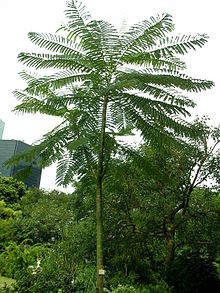| Schizolobium | |
|---|---|

| |
| Scientific classification | |
| Kingdom: | Plantae |
| Clade: | Tracheophytes |
| Clade: | Angiosperms |
| Clade: | Eudicots |
| Clade: | Rosids |
| Order: | Fabales |
| Family: | Fabaceae |
| Subfamily: | Caesalpinioideae |
| Genus: | Schizolobium Vogel |
| Species: | S. parahyba
|
| Binomial name | |
| Schizolobium parahyba | |
| Synonyms[1] | |
| |

Schizolobium parahyba, the Brazilian firetree, or Brazilian fern tree, is a species of tree from tropical America. It is the sole species in genus Schizolobium.[2][3] It is notable for its fast growth (up to 3 meters per year).[4] According to Francis Hallé, this tree may even reach 30 meters high in only five years, which would make it one of the fastest growing trees ever (an average growth of 6 meters per year).[5]
The tree is locally known by many names, including guapuruvu, guapiruvu, bacurubu, ficheira ("token tree"), faveira ("fava tree"), pau-de-vintém ("penny-wood"), pau-de-tamanco ("clog-wood"), umbela, and parica. It was first described by J. M. C. Vellozo in 1825 under the name Cassia parahyba. The species name likely refers to the Paraíba River in Southeast Brazil.
- ^ Schizolobium parahyba (Vell.) S.F.Blake. Plants of the World Online. Retrieved 19 September 2023.
- ^ Schizolobium Vogel. Plants of the World Online. Retrieved 19 September 2023.
- ^ Schizolobium Vogel. World Flora Online. Retrieved 19 September 2023.
- ^ Cite error: The named reference
sazimawas invoked but never defined (see the help page). - ^ Hallé, Francis (2005). Plaidoyer pour l'arbre, p. 57 (Actes Sud)